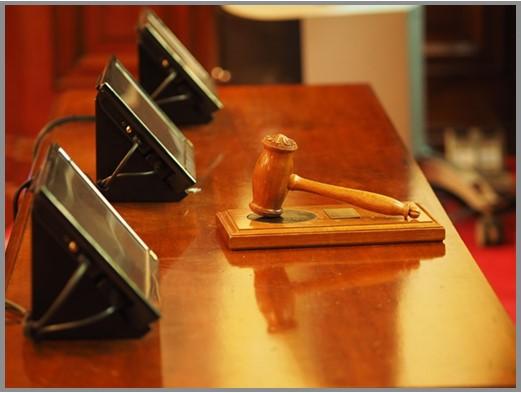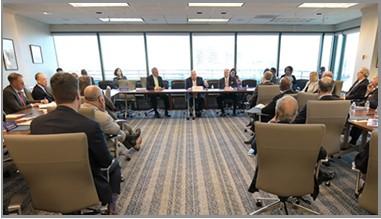
FS-1167 | March 2021
Troubleshooting Difficult Board Dynamics

A board brings together different personalities, all passionate about their role. It takes work and skill to balance all of them in one setting. One of the most efficient ways to ensure everyone has input and is valued is by properly applying parliamentary procedure. Applying Roberts Rules of Order allows boards to establish and maintain decorum, ascertain the will of the majority, preserve the rights of the minority, and facilitate the orderly transaction of business. However, when passionate people come together, eventually there will be differences of opinion. Each board member needs to be comfortable with disagreement and feel confident enough with basic parliamentary procedure to find a way to redirect energy and/or emotion to come to the best decision for the group.
Getting the right behaviors and dynamics on a board and between board members is an essential ingredient for successful organizations. Each board member has a key role in navigating the group dynamics to ensure the board has a productive culture.
This factsheet explores:
- some of the tensions that can hinder progress in decision making, stifle honest independent thought, and cause undue stress for everyone involved;
- what members and chairs can do to properly address difficult situations to move forward to decisions;
- useful insight and advice on how to set the tone for the board and manage difficult dynamics.
Challenges for Boards can Come from Several Sources

The habits and actions of members and/or chairs may cause tensions in a meeting. In other cases, the dynamics of the group may be a problem. Here are examples of the types of personalities that can create challenges during meetings. We have also provided suggestions for troubleshooting and properly addressing particular difficult personalities.
The bully board member tries to intimidate others, resulting in other board members not expressing their opinions or voting. Good decisions could turn bad because people vote to go along with the bully member instead of how they truly feel.
The bully member:
- may be confrontational, through words or body language;
- speaks over others or interrupts;
- searches for flaws in everything, stifling creativity and others’ comments;
- can indirectly encourage others to behave similarly.
One important rule from Roberts Rules of Order has to do with “decorum during debate.” The rule stresses that in debate, remarks should relate only to the question or motion. The board chairman or other members can demand civility and courtesy in language. The chair can insist on solutions rather than contradictions. The chair or other members should emphasize that it is not the individual, but the motion that is subject to debate. Ultimately, what matters is the opinion of the whole board, not those of a few or a single bully member. Every board member must vote how they feel after considering all relevant information rather than being swayed or pressured by other board members.
The demanding board member can be very loud, threatening and often times verbally aggressive. This type of member can create an extremely negative environment, which hinders the progress of business and takes away from the fairness parliamentary procedure is intended to ensure.
The demanding member:
- uses inappropriate language such as cursing, raising voice, pointing fingers;
- adopts an abusive or attacking tone and body language, targeting comments to particular people;
- intimidates others to agree with his/her opinion or say nothing.
There are several options for handling these types of members. One method would be to take a recess, which can be called by the chair or requested by other board members. A recess can often give everyone time to calm down and when the meeting is reconvened, members can discuss topics more professionally. The most important thing each board member can do is vote appropriately and don’t compromise based on the demanding member’s actions. Yielding to the demanding member will ensure that he/she will continue to behave that way to influence votes.
The conversationalist member is very talkative during meetings, often adding conversations that are not items of business or motions of action. Unrelated conversations can lengthen meetings when discussions stray from the agenda. Longer meetings can frustrate other board members.
The conversationalist member:
- leads discussion in irrelevant directions;
- repeats comments;
- consumes discussion time;
- causes business items to be postponed or rushed through because there is not enough discussion time.
To address the very talkative member, the chair or any board member should interject to keep discussion focused on the pending topic or motion. It is important that members do not become so distracted that they forget the topic of discussion or tune out during the tangent. Members who do not stay focused may be less prepared when a motion comes to a vote.
Boards also can limit speaking time to first-time speakers and/or new information. This allows quiet board members that have not spoken yet to contribute and helps eliminate duplicate facts and comments.
The pleaser chair tries to keep everyone happy, which may result in indecisiveness that leads to no or incorrect decisions.
The pleaser chair:
- prefers lengthy discussion to find consensus;
- wants clear consensus before the official vote;
- tables topics until the next meeting to avoid a mixed vote.
The good news is that any board member can help remedy this type of situation by requesting the use of parliamentary procedure. Boards can move to limit debate to a certain length, new content, or new speakers. Ideally, the chair would know when discussion is not progressing and call for a vote. If the chair does not act, any member also can call for a vote if they feel discussion has been exhausted.
The controlling chair is the opposite of the pleaser chair. The controlling chair takes a dominating, and sometimes even aggressive approach to leading the board. As a result, some members or certain discussion may be ignored or discouraged.
This type of chair is:
- overpowering;
- aggressive;
- stifling or discrediting discussion of opposing views.
Parliamentary procedure was created to give every board member a chance to be heard. In addition, the chair role is meant to be a facilitator, not a dictator. The chair should remain neutral and facilitate constructive discussion of all viewpoints. All members should be familiar with parliamentary procedure and the chair should be confident enough to stand up to a group to follow it. Board members can challenge the chair when he/she is not following procedure by calling for “point of order.”
The social club chair often blends personal and professional views to the extent of being detrimental. Under this type of chair, meetings are friendly, but often spend so much time on social discussion that it hinders necessary business.
This type of chair is:
- informal or unfocused;
- too focused on visiting with friends;
- is lenient about allowing individual conversations during the meeting instead of before/after.
The best remedy is to use parliamentary procedure to help the meeting stay on task. If an agenda exists but is not being followed, any member can call for orders of the day to make the group come back to the agenda to stay on task. All board members can encourage discussion items and process through voting. If there is a motion and second on the floor, any member can call for a point of order to bring discussion back to the motion or can call for a vote, if all productive discussion is over. Encouraging different opinions and ideas can sometimes give the discussion back to the members. If needed, members can clarify their role and right to discuss the motion at hand. If there are not sufficient business items, meetings should be cancelled, instead of gathering everyone with no plan of what to discuss.
The exclusive chair can be dangerous by stifling input or new ideas or preventing transparency. An exclusive chair often presents statements of what the board will do, instead of allowing members to discuss and vote. It may also take the form of discussing the issue only with certain members before the meeting so the outcome is already “decided” before the meeting.
This type of chair:
- is secretive; entrenched;
- discourages input or new ideas;
- has “secret squirrel meetings.”
Board members can insist on openness of a subject discussions or question the relevancy to the mission if business items seem secretive. Each member can ask questions and compliment each other’s discussion to discourage dismissal of an idea. Proper use of parliamentary procedure can also help ensure there is effective discussion of a subject and proper vote.
If a chair is not following procedure, members can point it out by calling for a vote or asking for a specific motion. It is important to remember that decisions are made by member voting, not determined by any individual. It is every board member’s responsibility to ensure procedure is followed.
The dissatisfied chair may be unhappy with member comments or appear to dismiss ideas quickly. He/she often misunderstands the role of the chair or uses the role to advance a personal agenda. The dissatisfied chair commonly wants to tell the group what will and will not work without properly facilitating discussion. If the chair does not favor a topic, he/she may not allow discussion.
This type of chair:
- always undermines the majority;
- and leads “parking lot rebellions.”
All members of a board need to remember that it is okay to disagree, but decisions are ultimately the result of a vote. Members need to remind the chair that he/she can only act within the rules of parliamentary procedure and the organization bylaws. Decisions on issues can only be made by vote.

Don’t Make these Meeting Mistakes
The purposeless meeting occurs when there is very little or no business to discuss. Serving on a board is a time commitment, and members’ time should be respected. If members’ commute to attend is longer than the actual meeting, it may be a sign that having the meeting should be reconsidered.
It is important for board leadership and members to be aware of what business there is to address. If business can wait or there is no business, consider canceling the meeting. Asking for agenda items ahead of time can also help determine if a meeting has enough business to justify convening. If this is a recurring issue, it may be time for the board to reconsider the structure of the meeting or even the mission of the board.
The overloaded meeting has so many agenda items that it becomes detrimental to thorough discussion and examination of each item. If meetings go on too long, board members may get tired, loose attention, or leave before the meeting is over.
This type of meeting is:
- too packed with discussion items;
- unable to fully discuss items.
Overloaded meetings may be modified by deciding which agenda items are the most pressing, while saving other items for a future meeting, if possible. Changing the start and/or end time of meetings to accommodate the amount of business can allow members to be prepared for long meetings. Incorporating break times can help rejuvenate members so that they give each item of business its due process. The board can also manage discussion times by delegating particular topics to committees. The committees can discuss items at length and make final recommendations or provide a report, saving the full board time.
The lethargic meeting is another common issue. These meetings are long, but do not feel productive or time efficient. Lethargic meetings can be challenging for board members because they may get distracted and not pay complete attention when something important comes up. Meetings that start late or are not efficient are not respectful of members’ time.
This type of meeting is:
- late starting;
- long winded;
- and slow and boring.
Including time markers in agendas can help keep meetings running on time. Time markers also allow all members to consider how the meeting will progress and call out any time management concerns. When potential lengthy discussions are a concern, enforcing debate times can help ensure everyone has an opportunity to speak and that each person is direct and to the point during their time. Establishing debate times can also ensure he/she feels the discussion has been exhausted and may be repetitive or fail to include new ideas or content.
Sources
- Eisenstein, W., & Eisenstein, L. (2019, January 11). The Nonprofit's Guide to Parliamentary Procedure. Retrieved October 27, 2020, from https://www.boardeffect.com/blog/the-nonprofits-guide-to-parliamentary-procedure/
- Robert, G. (n.d.). Robert's Rules of Order. Retrieved October 27, 2020, from https://www.parliamentaryprocedure.net/roberts-rules.html
- Robert, H. M., Robert, S. C., Seabold, D. E., & Gerber, S. (2011). "Robert's Rules of Order: Newly Revised, 11th Edition". Eclipse Publishing Services. doi: http://robertsrules.com/
LACIE ASHBY
lashby@udel.edu
This publication, Troubleshooting Difficult Board Dynamics (FS-1167), is a part of a collection produced by the University of Maryland Extension and the Department of 4-H Youth Development within the College of Agriculture and Natural Resources.
The information presented has met UME peer-review standards, including internal and external technical review. For help accessing this or any UME publication contact: itaccessibility@umd.edu
For more information on this and other topics, visit the University of Maryland Extension website at extension.umd.edu
University programs, activities, and facilities are available to all without regard to race, color, sex, gender identity or expression, sexual orientation, marital status, age, national origin, political affiliation, physical or mental disability, religion, protected veteran status, genetic information, personal appearance, or any other legally protected class.